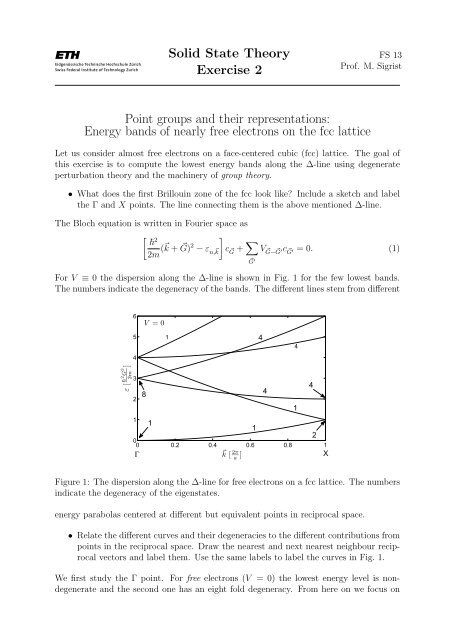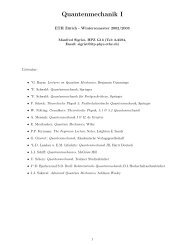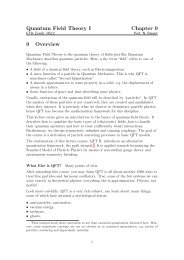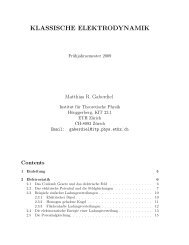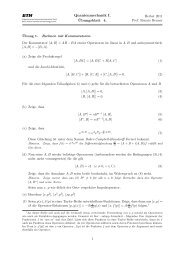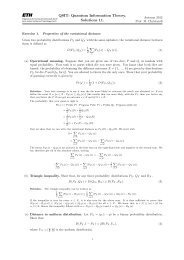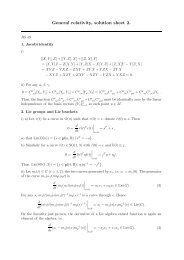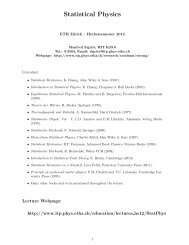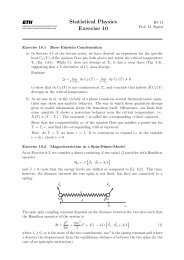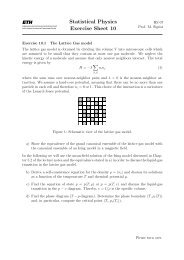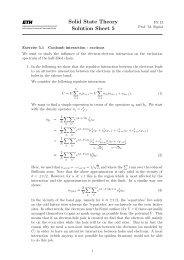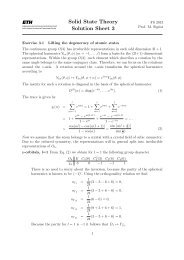Solid State Theory Exercise 2 Point groups and their representations ...
Solid State Theory Exercise 2 Point groups and their representations ...
Solid State Theory Exercise 2 Point groups and their representations ...
You also want an ePaper? Increase the reach of your titles
YUMPU automatically turns print PDFs into web optimized ePapers that Google loves.
<strong>Solid</strong> <strong>State</strong> <strong>Theory</strong><br />
<strong>Exercise</strong> 2<br />
FS 13<br />
Prof. M. Sigrist<br />
<strong>Point</strong> <strong>groups</strong> <strong>and</strong> <strong>their</strong> <strong>representations</strong>:<br />
Energy b<strong>and</strong>s of nearly free electrons on the fcc lattice<br />
Let us consider almost free electrons on a face-centered cubic (fcc) lattice. The goal of<br />
this exercise is to compute the lowest energy b<strong>and</strong>s along the ∆-line using degenerate<br />
perturbation theory <strong>and</strong> the machinery of group theory.<br />
• What does the first Brillouin zone of the fcc look like? Include a sketch <strong>and</strong> label<br />
the Γ <strong>and</strong> X points. The line connecting them is the above mentioned ∆-line.<br />
The Bloch equation is written in Fourier space as<br />
[ ]<br />
<br />
2<br />
2m (⃗ k + G) ⃗ 2 − ε n, ⃗ k<br />
c ⃗G + ∑ G ⃗ ′<br />
V ⃗G− ⃗ G ′c ⃗G ′ = 0. (1)<br />
For V ≡ 0 the dispersion along the ∆-line is shown in Fig. 1 for the few lowest b<strong>and</strong>s.<br />
The numbers indicate the degeneracy of the b<strong>and</strong>s. The different lines stem from different<br />
6<br />
V = 0<br />
5<br />
1<br />
4<br />
4<br />
4<br />
ε [ ¯h2 G 2<br />
2m ]<br />
3<br />
2<br />
8<br />
1<br />
1<br />
1<br />
2<br />
0<br />
0 0.2 0.4 0.6 0.8 1<br />
⃗ k [<br />
2π<br />
Γ<br />
a ]<br />
X<br />
4<br />
1<br />
4<br />
Figure 1: The dispersion along the ∆-line for free electrons on a fcc lattice. The numbers<br />
indicate the degeneracy of the eigenstates.<br />
energy parabolas centered at different but equivalent points in reciprocal space.<br />
• Relate the different curves <strong>and</strong> <strong>their</strong> degeneracies to the different contributions from<br />
points in the reciprocal space. Draw the nearest <strong>and</strong> next nearest neighbour reciprocal<br />
vectors <strong>and</strong> label them. Use the same labels to label the curves in Fig. 1.<br />
We first study the Γ point. For free electrons (V = 0) the lowest energy level is nondegenerate<br />
<strong>and</strong> the second one has an eight fold degeneracy. From here on we focus on
the second energy level.<br />
As you found in the previous part, the 8-fold degeneracy stems from parabolas centered<br />
at the 8 points connected to Γ by the following reciprocal lattice vectors:<br />
⃗G 1 = G(1, 1, 1), G2 ⃗ = G(−1, 1, 1),<br />
⃗G 3 = G(−1, −1, 1), G4 ⃗ = G(1, −1, 1),<br />
⃗G 5 = G(1, 1, −1), G6 ⃗ = G(−1, 1, −1),<br />
⃗G 7 = G(−1, −1, −1), G8 ⃗ = G(1, −1, −1),<br />
(2)<br />
where G = 2π . These vectors form an 8 dimensional Hilbertspace, <strong>and</strong> the eigenfunctions<br />
a<br />
are given by<br />
ψ j (⃗r) = 〈⃗r| G ⃗ j 〉 = ei G ⃗ j·⃗r<br />
√ . (3)<br />
V<br />
The point group of the cubic Bravais lattices (simple cubic, fcc, bcc) is denoted by O h<br />
(symmetry group of a cube). Its character table is given in Tab. 1.<br />
O h E C 3 (8) C4(3) 2 C 2 (6) C 4 (6) J JC 3 (8) JC4(3) 2 JC 2 (6) JC 4 (6)<br />
[xyz] [zxy] [¯xȳz] [yx¯z] [ȳxz] [¯xȳ¯z] [¯z¯xȳ] [xy¯z] [ȳ¯xz] [y¯x¯z]<br />
1 1 1 1 1 1 1 1 1 1<br />
1 1 1 1 1 −1 −1 −1 −1 −1<br />
1 1 1 −1 −1 1 1 1 −1 −1<br />
1 1 1 −1 −1 −1 −1 −1 1 1<br />
2 −1 2 0 0 2 −1 2 0 0<br />
2 −1 2 0 0 2 1 −2 0 0<br />
3 0 −1 −1 1 3 0 −1 −1 1<br />
3 0 −1 −1 1 −3 0 1 1 −1<br />
3 0 −1 1 −1 3 0 −1 1 −1<br />
3 0 −1 1 −1 −3 0 1 −1 1<br />
χ Γ<br />
+<br />
1<br />
χ Γ<br />
−<br />
1<br />
χ Γ<br />
+<br />
2<br />
χ Γ<br />
−<br />
2<br />
χ Γ<br />
+<br />
12<br />
χ Γ<br />
−<br />
12<br />
χ Γ<br />
+<br />
15<br />
χ Γ<br />
−<br />
15<br />
χ Γ<br />
+<br />
25<br />
χ Γ<br />
−<br />
25<br />
Table 1: The character table of the cubic point group O h .<br />
We will denote the eight-dimensional representation of O h defined on this subspace by Γ.<br />
Find the irreducible <strong>representations</strong> contained in Γ. To this end, we compute the group<br />
character χ Γ <strong>and</strong> use the character table of O h to show that<br />
The representation Γ of O h on this subspace is defined as<br />
where g ∈ O h .<br />
Γ = Γ + 1 ⊕ Γ − 2 ⊕ Γ − 15 ⊕ Γ + 25. (4)<br />
ˆΓ(g)| ⃗ G j 〉 = |g ⃗ G j 〉 (5)<br />
• How does a real space vector ⃗r change under the action of such a symmetry operation?
It is easy to see that each element of the cubic point group simply permutes the G ⃗ j ’s. For<br />
example, a rotation by π/2 around the z-axis is represented as<br />
⎛<br />
⎞<br />
0 1 0 0 0 0 0 0<br />
0 0 1 0 0 0 0 0<br />
0 0 0 1 0 0 0 0<br />
Rπ/2 z =<br />
1 0 0 0 0 0 0 0<br />
0 0 0 0 0 1 0 0<br />
.<br />
⎜ 0 0 0 0 0 0 1 0<br />
⎟<br />
⎝ 0 0 0 0 0 0 0 1 ⎠<br />
0 0 0 0 1 0 0 0<br />
The character of this transformation is χ Γ (Rπ/2 z ) = tr(Rz π/2<br />
) = 0. Clearly, in order to find<br />
all the characters of the representation Γ defined by Eq. (5) we don’t have to compute all<br />
the matrices. Instead, we simply have to know how many of the G ⃗ i ’s are invariant under<br />
a certain element.<br />
• Explain shortly why one obtains the character in this case simply by counting the<br />
invariant ⃗ G i ’s.<br />
It is sufficient to consider one element of each conjugacy class. In the following, J will<br />
denote the inversion, C 3 (8) the conjugacy class of rotations by 2π/3 around one of the<br />
diagonals of the cube, C 4 (6) the conjugacy class of the rotations by π/2, C 2 (6) the conjugacy<br />
class of rotations by π around an axis through the edges of the cube <strong>and</strong> C 2 4(3)<br />
the conjugacy class of the rotations by π around an axis through surface of the cube.<br />
(The number in brackets denotes the number of elements in the corresponding conjugacy<br />
class.)<br />
• Complete the following character table<br />
E C 3 (8) C 2 4(3) C 2 (6) C 4 (6) J JC 3 (8) JC 2 4(3) JC 2 (6) JC 4 (6)<br />
χ Γ . . . . 0 . . . . .<br />
Using the orthogonality of the characters we can compute how many times the irreducible<br />
representation Γ ± i is contained in Γ:<br />
〈 〉<br />
n Γ<br />
± = χ Γ , χ<br />
i<br />
Γ<br />
± := 1 ∑<br />
χ Γ (g)χ<br />
i |O h |<br />
Γ<br />
± (g) = 1 ∑<br />
χ Γ (C n )χ<br />
i |O h |<br />
Γ<br />
± (C n) |C n |<br />
i<br />
g∈O h C n<br />
where C n denotes the conjugacy classes of O h , |C n | the order of the conjugacy class (e.g.<br />
C 3 (8) has 8 elements) <strong>and</strong> |O h | = 48 the order of the group. One computes<br />
n Γ<br />
+ = 1 (8 + 2 × 8 + 4 × 6) = 1 (6)<br />
1 48<br />
Similarly, one finds n Γ<br />
− = n<br />
2 Γ − = n 15 Γ + = 1, while all the others are 0. Therefore,<br />
25<br />
Γ = Γ + 1 ⊕ Γ − 2 ⊕ Γ − 15 ⊕ Γ + 25. (7)<br />
A finite periodic potential will in general split the second energy level at the Γ point.<br />
Applying degenerate perturbation theory to the Bloch equation [Eq. (1.27) in the lecture<br />
notes] leads to an 8 × 8 matrix with off-diagonal elements u = V 4π<br />
(1,1,1), v = V 4π (1,0,0) <strong>and</strong><br />
a a<br />
w = V 4π<br />
(1,1,0).<br />
a
• Check for yourself that this matrix is given by<br />
⎛<br />
⎞<br />
E 0 − ε v w v v w u w<br />
v E 0 − ε v w w v w u<br />
w v E 0 − ε v u w v w<br />
A =<br />
v w v E 0 − ε w u w v<br />
v w u w E 0 − ε v w v<br />
⎜ w v w u v E 0 − ε v w<br />
⎟<br />
⎝ u w v w w v E 0 − ε v ⎠<br />
w u w v v w v E 0 − ε<br />
This matrix can be diagonalized by going into the symmetry subspaces. We will show<br />
that for the energies <strong>and</strong> the wave functions one finds<br />
where E 0 = 2<br />
2m 3( 2π a )2 .<br />
Γ + 1 : E 0 + u + 3v + 3w cos ( 2π<br />
x) cos ( 2π<br />
y) cos ( 2π<br />
z) ;<br />
a a a<br />
Γ − 2 : E 0 − u − 3v + 3w sin ( 2π<br />
x) sin ( 2π<br />
y) sin ( 2π<br />
z) ;<br />
a a a<br />
Γ − 15 : E 0 − u + v − w { sin ( 2π<br />
x) cos ( 2π<br />
y) cos ( 2π<br />
z) , cyclic } { (<br />
;<br />
a a a<br />
Γ + 25 : E 0 + u − v − w cos 2π x) sin ( 2π<br />
y) sin ( 2π<br />
z) , cyclic } ;<br />
a a a<br />
(8)<br />
For V ≠ 0 the wave functions ψ j (⃗r) mix. Applying degenerate perturbation theory means<br />
we have to solve the secular equation:<br />
det A = 0<br />
which has to be solved for ε. By projecting suitable vectors onto the symmetry subspaces<br />
found in a) one can systematically construct an eigenbasis <strong>and</strong> with it find the energies.<br />
However, for relatively small systems it is often possible to guess the correct eigenfunctions<br />
using some symmetry properties of the basis functions of the irreducible <strong>representations</strong>.<br />
Since the physical eigenfunctions have to be periodic in real space it is natural to use<br />
combinations of cos(Gx) <strong>and</strong> sin(Gx) etc.<br />
1. The eigenfunction belonging to the subset Γ + 1 has to be totally symmetric under<br />
all the operations. Therefore, e 1 = ( 1 1 1 1 1 1 1 1 ) is an eigenvector<br />
with energy ε 1 = E 0 + u + 3v + 3w. The physical eigenfunction can be found as<br />
f 1 (⃗r) ∼ ∑ j ei ⃗ G j ⃗r ∼ cos(Gx) cos(Gy) cos(Gz).<br />
2. For Γ − 15 we need three functions which are odd under the inversion operation ⃗r → −⃗r.<br />
We therefore need an odd number of sin’s. What is left are the combinations<br />
f 3 (⃗r) ∼ sin(Gx) cos(Gy) cos(Gz), f 4 (⃗r) ∼ cos(Gx) sin(Gy) cos(Gz) <strong>and</strong> f 5 (⃗r) ∼<br />
cos(Gx) cos(Gy) sin(Gz). They correspond to the following vectors<br />
e 3 = ( 1 −1 −1 1 1 −1 −1 1 )<br />
e 4 = ( 1 1 −1 −1 1 1 −1 −1 )<br />
e 5 = ( 1 1 1 1 −1 −1 −1 −1 )<br />
with energy ε 3−5 = E 0 − u + v − w.<br />
• Using the character table, repeat the above steps to find the eigenfunction f 2 (⃗r)<br />
belonging to the subset Γ − 2 . Also compute its energy.
• Again, repeat the above for the eigenfunctions <strong>and</strong> energy belonging to the subspace<br />
Γ + 25.<br />
How do the irreducible <strong>representations</strong> split on the ∆-line? The ∆-line is defined by the<br />
points ⃗ k = 2π (0, 0, δ), 0 ≤ δ ≤ 1 (i.e. we choose the z-axis going through X). Use the<br />
a<br />
character table of C 4v .<br />
C 4v E C 2 (1) C 4 (2) σ v (2) σ d (2)<br />
[xyz] [¯xȳz] [y¯xz] [¯xyz] [yxz]<br />
χ ∆1 1 1 1 1 1<br />
χ ∆2 1 1 1 −1 −1<br />
χ ∆3 1 1 −1 1 −1<br />
χ ∆4 1 1 −1 −1 1<br />
χ ∆5 2 −2 0 0 0<br />
Table 2: The character table of C 4v .<br />
On the ∆-line the number of symmetry operations which leave the ⃗ k-vector invariant is<br />
reduced. Only the rotations around the z-axis or the reflections on mirror planes containing<br />
the z-axis leaves the ⃗ k-vector invariant. The ”small group” is now C 4v , the symmetry<br />
group of a square. Under these reduced operations, the irreducible <strong>representations</strong> of O h<br />
will in general split into irreducible <strong>representations</strong> of C 4v .<br />
(i) Of course, the trivial representation of O h changes to the trivial representation of C 4v :<br />
Γ + 1 ↦→ ∆ 1 .<br />
(ii) Under the operations of C 4v the group character of Γ − 2 is easily found using the<br />
properties of the basis function f 2 (⃗r):<br />
C 4v E C4 2 C 4 σ v σ d<br />
1 1 −1 −1 1<br />
χ Γ<br />
−<br />
2<br />
This is the character of ∆ 4 <strong>and</strong> therefore Γ − 2 ↦→ ∆ 4 .<br />
(9)<br />
• Using the basis functions {f 3 (⃗r), f 4 (⃗r), f 5 (⃗r)}, find the matrix belonging to the different<br />
conjugacy classes. For example, a matrix belonging to the conjugacy class<br />
C 4 ([y¯xz]) would be computed as follows. Consider the function f 3 (x, y, z); then<br />
performing a C 4 rotation, this function becomes f 3 (y, −x, z). Inspection of this latter<br />
function shows that it is identical to f 4 (x, y, z), explaining the first row of the<br />
following matrix:<br />
⎛ ⎞<br />
0 1 0<br />
C 4 ([y¯xz]) = ⎝ −1 0 0 ⎠ (10)<br />
0 0 1<br />
It is imporant to realize that this transformation acts on the basis functions (imagine<br />
a vector (f 3 , f 4 , f 5 ) on which this matrix acts). In this case, the matrix can also<br />
be found by considering simply the vector (x, y, z) → (y, −x, z)).<br />
Then compute the group character <strong>and</strong> extract the irreducible <strong>representations</strong> by<br />
using the orthogonality of the characters (as in the first part of this exercise).
C 4v E C4 2 C 4 σ v σ d<br />
. . . . .<br />
χ Γ<br />
−<br />
4<br />
(11)<br />
(iii) For Γ + 25 we will find in an analogous way<br />
C 4v E C4 2 C 4 σ v σ d<br />
3 −1 −1 −1 1<br />
χ Γ<br />
+<br />
25<br />
(12)<br />
<strong>and</strong> therefore Γ + 5 ↦→ ∆ 4 ⊕ ∆ 5 .<br />
Let us now consider the point X = 2π (0, 0, 1). The lowest level is two fold <strong>and</strong> the second<br />
a<br />
four fold degenerate for V = 0. Compute the energies <strong>and</strong> the wave functions for these<br />
two levels.<br />
( )<br />
At the point X = 2π a 0 0 1 the symmetry is larger than along the ∆-line, but smaller<br />
than the full group O h . It contains all the elements of O h which map z to z or to −z.<br />
This group is called D 4h . In order to compute the lifting of the degeneracy of the lowest<br />
two levels we can simply diagonalize the corresponding matrices. The irreducible representation<br />
of D 4h are given in Table 3.<br />
even basis function d X odd basis function d X<br />
X + 1 1 1 X − 1 xyz(x 2 − y 2 ) 1<br />
X + 2 xy(x 2 − y 2 ) 1 X − 2 z 1<br />
X + 3 x 2 − y 2 1 X − 3 xyz 1<br />
X + 4 xy 1 X − 4 z(x 2 − y 2 ) 1<br />
X + 5 zx, zy 2 X − 5 x, y 1<br />
Table 3: Irreducible <strong>representations</strong> of D 4h , split according to <strong>their</strong> parity (z → z or<br />
z → −z. The dimension of the irreducible representation is indicated in the column<br />
labeled d X .<br />
Lowest level: The G-vectors ⃗ entering the Bloch equation in lowest order in the periodic<br />
potential are G ⃗ 0 = 0 <strong>and</strong> G ⃗ 9 = 2G(0, 0, 1). Furthermore, v = V ⃗G0 −G ⃗ 9<br />
enters as well.<br />
• Construct the secular equation, <strong>and</strong> find the eigenvectors.<br />
The eigenfunctions you find from the vectors are cos Gz <strong>and</strong> sin Gz, respectively. Comparing<br />
this to the irreducible <strong>representations</strong> of D 4h we find that e 1 corresponds to X + 1<br />
<strong>and</strong> e 2 to X − 2 .<br />
Second-lowest level: The G-vectors ⃗ entering the Bloch equation in lowest order in the<br />
periodic potential are G ⃗ 1 to G ⃗ 4 <strong>and</strong> we have to diagonalize the matrix<br />
⎛<br />
⎞<br />
2 2 G 2<br />
v w v<br />
2m v 2 2 G 2<br />
v w<br />
⎜<br />
2m ⎝ w v 2 2 G ⎟<br />
2<br />
v ⎠ .<br />
2m<br />
v w v 2 2 G 2<br />
2m
Here, v <strong>and</strong> w have the same meaning as above. From the symmetry of the matrix it is<br />
clear that the eigenvectors are of the form (a, b, b, a) <strong>and</strong> (a, b, −b, −a). One then finds<br />
e 1 = ( 1 1 1 1 ) <strong>and</strong> E 1 = 2 2 G 2<br />
+ 2v + w,<br />
2m<br />
e 2 = ( 1 1 −1 −1 ) <strong>and</strong> E 2 = 2 2 G 2<br />
2m − w,<br />
e 3 = ( 1 −1 −1 1 ) <strong>and</strong> E 3 = 2 2 G 2<br />
2m − w,<br />
e 4 = ( 1 −1 1 −1 ) <strong>and</strong> E 4 = 2 2 G 2<br />
− 2v + w.<br />
2m<br />
• Compare these results again to the eigenfunctions given in Table 3, <strong>and</strong> identify the<br />
irreducible <strong>representations</strong> they belong to.<br />
• Finally, sketch the energy b<strong>and</strong>s between the Γ <strong>and</strong> the X point <strong>and</strong> compare it to<br />
the free electron (V = 0 case). For an actual numerical calculation use the values<br />
u = −0.05, v = 0.05 <strong>and</strong> w = 0.1 (in units of (2π)2<br />
2ma 2 ).<br />
Contact Person:<br />
Evert van Nieuwenburg (HIT K 23.7)<br />
evertv@itp.phys.ethz.ch


